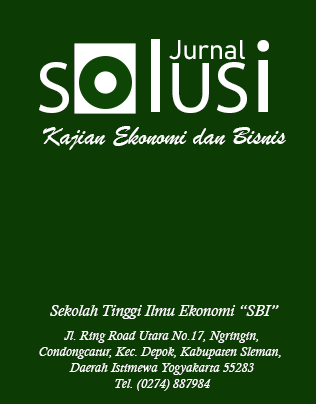The Influence of Player Satisfaction, Virtual Item Value, and Collaboration Branding on Purchase Intention Gacha in the Japanese Game "Pigg Party"
Main Article Content
Abstract
ABSTRACT
The purpose of this study is to examine the effect of Player Satisfaction, Virtual Item Value, and Collaboration Branding of PIGG PARTY gacha. Gacha in free-to-play games can be done with free game coins/tickets and obtained normal to rare items that can be done by purchasing game coins with real money. This study used primary data collected from respondents who were PIGG PARTY players with the minimum age of 17 years old and had been purchasing gacha. The respondent were approached through PIGG PARTY Facebook group, Discord, WhatsApp and in PIGG PARTY game who were given the link to the online questionnaire set in google form which provided 100 data. The technique for analyzing data was Structural Equation Modeling - Partial Least Square (SEM-PLS) using the SmartPLS 3.0 application. With the results of this study explained that: 1) Player Satisfaction has a possitively affects on Purchase Intention, 2) Virtual Item Value significantly and positively affects on Purchase Intention, 3) Collaboration Branding has a significantly positive.
Keywords: satisfaction player, virtual item value, Collaboration Branding, purchase intention
Article Details

This work is licensed under a Creative Commons Attribution-NonCommercial-ShareAlike 4.0 International License.
Jurnal SOLUSI memberikan akses terbuka terhadap siapapun agar informasi dan temuan pada artikel tersebut bermanfaat bagi semua orang. Semua konten artikel Jurnal ini dapat diakses dan diunduh secara gratis, tanpa dipungut biaya, sesuai dengan lisensi creative commons yang digunakan.
References
Akbar, A. (2018). Misteri “Gacha”, Kenapa Begitu Populer di Kalangan Gamer Jepang?
Gamebrott. gamebrott.com. https://gamebrott.com/misteri-gacha-kenapa-begitu-populer-
di-kalangan-gamer-jepang
Aryudi, Y. B. (2021). Analisis Pengaruh Perceived Value, Promosi Penjualan Dan Influencer
Marketing Terhadap Minat Pembelian (Studi Pada Pengguna Aplikasi Video Game Gratis).
Universitas Brawijaya.
file:///C:/Users/Wendri/Downloads/agusafeb,+Yudistira+Bramasta+Aryudi.pdfSOLUSI: Jurnal Kajian Ekonomi Dan Bisnis P- ISSN 1907-2376
Vol 20, No.1, 2025, Hal. 44 - 57 E - ISSN 2797-8699
Bakti, U., Hairudin, & Septijantini Alie, M. (2020). Pengaruh Kualitas Pelayanan, Produk dan
Harga Terhadap Minat Beli Pada Toko Online Lazada di Bandar Lampung. Jurnal Ekonomi,
(1), 101–105. https://doi.org/https://doi.org/10.37721/je.v22i1.633
Ballester, E. D., & Espallardo, M. H. (2008). Evaluations of Branding Alliances Between Non-
Profit and Commercial Brand Partners: The Transfer of Affect. Journal of Marketing,
(9/10).
https://www.emerald.com/insight/content/doi/10.1108/03090560810891091/full/html
Blackett, T., & Boad, B. (1999). Co-Branding The Science Of Alliance (1st ed.). Palgrave
Macmillan.
CyberAgent. (2023). Pigg on to the next stage continues to create a place to express, aiming for
avatar social app: From “Ameba Pigg” To “PIGG PARTY”, The Pigg’s History.
Cyberagent.Co. https://www.cyberagent.co.jp.
Ferdinand, A. (2006). Metode Penelitian Manajemen : Pedoman Penelitian untuk Penulisan
Skripsi, Tesis, dan Disertasi Ilmu Manajemen. Badan Penerbit Universitas Diponegoro.
Game-i. (2024). Pigg Party game app analysis, last 60 days transition graph. https://game-
i.daa.jp/?cmd=app_record&apid=966099615
Guo, Y., & Barnes, S. (2009). Virtual item purchase behavior in virtual worlds: An exploratory
investigation. Electronic Commerce Research, 9(1–2), 77–96.
https://doi.org/https://doi.org/10.1007/s10660-009-9032-6
Haryanto, A. T. (2024). APJII Jumlah Pengguna Internet Indonesia Tembus 221 Juta Orang.
Asosiasi Penyelenggara Jasa Internet Indonesia. https://apjii.or.id/berita/d/apjii-jumlah-
pengguna-internet-indonesia-tembus-221-juta-orang
Hasan, A. (2009). Marketing (1st ed.). MedPress.
https://web.facebook.com/PicoIndonesiaFanpage. (2023). Ameba Pico Indonesia. facebook.com.
https://web.facebook.com/PicoIndonesiaFanpage/?locale=id_ID&_rdc=1&_rdr
Irawan, H. (2008). Membedah Strategi Kepuasan Pelanggan (1st ed.). Gramedia.
Kotler, Philip, & Keller. (2009). Manajemen Pemasaran (Ketiga). Erlangga.
Sahid, S. A. (2018). Konsumsi Virtual Item Pada Gamer Jepang Dalam Social Game Fate or
Grand Order. Japanology, 7(1), 53–57. https://journal.unair.ac.id/JPLG@konsumsi-virtual-
item-pada-gamer-jepang-dalam-social-game-fate-grand-order--article-12610-media-44-
category-8.html
Searle, H., Nicholas, D. B., & Michigan, S. U. (2008). Perception of and Addiction to Online
Games as a Function of Personality Traits. Journal of Media Psychology, 13(2).
Sholihin, M., & Ratmono, D. (2021). Analisis SEM-PLS dengan WarpPLS 7.0 Untuk Hubungan
Nonliner Dalam Penelitian Sosial dan Bisnis (2nd ed). Andi Publiser.
Sugiyono. (2018). Metode Penelitian Kuantitatif, Kualitatif, dan R&D (2nd ed). Alfabeta.
Sugiyono. (2019). Metode Penelitian Kuantitatif Kualitatif Dan R&D. Alfabeta.
Wijman, T. (2023). Global Games Market Report 2023. Newzoo. http://www.daelab.cn/wp-
content/uploads/2023/09/2023_Newzoo_Free_Global_Games_Market_Report.pdf
